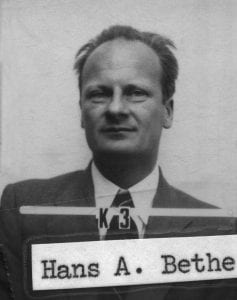
Background:
Hans Albrecht Bethe was born in 1906 in Strasbourg in Alsace-Lorraine. Which was then part of Germany. He attended the University of Frankfurt for two years and Munich for two and a half years. Eventually receiving a Ph.D. in theoretical physics with a thesis on electron diffraction in crystals.
Bethe then became a physics teacher in Frankfurt and Stuttgart. He worked at the University of Munich from 29 to fall ’33 becoming a Privatdozent (equivalent to a lecturer at UCSC) in May 1930. When the Nazi party rose to power he was dismissed from his position as acting assistant professor at the University of Tubingen. He first immigrated to England in the fall of 1933 to fill a temporary position at the University of Manchester and in 1935 immigrated to the United States to become an Assistant professor at Cornell. Later becoming a full professor in 1937.
He participated in the Washington conferences on Theoretical physics in 1935 and 1937. In the 1938 conference on stellar energy generation he participated in the development of proton-proton cycle. Inadequacies with the proton-proton cycle led him to pursue a model that would account for elements heavier than helium. Bethe was later awarded the Nobel Prize in physics in 1967 for his 1939 paper on energy generation in stars which described the carbon-nitrogen-oxygen cycle.
World War 2 and the Manhattan Project:
At the outbreak of the Second World War in 1939 Bethe wished to contribute to the war effort but could not work on anything that required a security clearance. Initially he worked with George Winter, an Austrian engineer specializing in the elasticity of steel, to write a paper on armor plate deformation. This was never published as it was marked as potentially significant to the war effort and therefore classified. Around the same time he wrote a paper with Edward Teller (see the Edward Teller entry) concerning how gases restore equilibrium in the wake of a shockwave.
Bethe became a US citizen in early 1941 and by the end of the year had received clearance to work on classified projects. He spent a year at the Radiation Laboratory at MIT working on radar technology. In 1943 he became the head of the Los Alamos Laboratory’s theoretical division. In this role he oversaw assessing the theoretical behavior of the evolving bomb designs. Including preliminary calculations to determine whether or not a bomb would ignite the atmosphere, calculation of critical mass, formulas for a bomb’s yield, and hydrodynamic aspects of an implosion device.
Postwar:
After the development of uranium and plutonium fission weapons he was involved with the development of the Teller-Ulam design. Outside of nuclear research went to do work in both quantum mechanics and astrophysics. Performing the calculation that verified the existence of Lamb Shift in August 1947. Even into his nineties he was still doing work pertaining to the properties of neutrinos emitted by the sun and with Gerald Brown researched why massive stars turn into supernovas.
Politically Bethe became a proponent of nuclear arms control and safe applications of nuclear power. He served on the President’s Science Advisory committee and helped to persuade President Eisenhower to support the Nuclear Test Ban Treaty of 1963. In the 1970’s and 1980’s he was an opponent of proposed anti-ICBM systems and Reagan’s Strategic Defense Initiative (The “star wars” program).
References:
Brown, Gerald E.; Lee, Sabine (2009). Hans Albrecht Bethe. Biographical Memoirs. Washington, D.C.: National Academy of Sciences. http://www.nasonline.org/publications/biographical-memoirs/memoir-pdfs/bethe-hans.pdf [Accessed 1/2/2018]
Nobelprize.org. “Hans Bethe – Biographical”. [online] Available at: http://www.nobelprize.org/nobel_prizes/physics/laureates/1967/bethe-bio.html [Accessed 1/2/2018]
Encyclopedia Britannica. (2018). Hans Bethe. [online] Available at: https://www.britannica.com/biography/Hans-Bethe [Accessed 1/4/2018]
Wikipedia.[2018]. Hans Bethe.[online]Available at: https://en.wikipedia.org/wiki/Hans_Bethe [Accessed 1/2/2018]

